Another beautiful day brightened the kingdom. After rousing Lewis from dreamland, we showered and dressed for the day's adventure.
The first real castle that I explored was Castel Sant'Angelo in Rome, in 1994. Begun in 134 AD as a mausoleum for Hadrian (a Roman Emperor and famous homosexual), Catholicism morphed it into a papal fortress during the 1300s. For Lewis and I, old structures exude charm and fascination. Therefore, coming to England necessitated a visit to Windsor Castle. It is a UNESCO World Heritage Site.
Taking advantage of our supreme location, we traipsed through Hyde Park, admiring how part of it is an expanse of emerald-green lawn, while other parts are preserved as untamed woodland for Mother Nature to enjoy.
Our quest to the castle began at Paddington Station. We were excited about our first rail journey in the UK. We needed to travel from London to the Royal Borough of Windsor & Maidenhead. This is it coat of arms.
*Long-distance trains are equipped with smartly-designed Sleeper Cars. Such accommodations are absent in the USA, despite much larger distances there.
There were plenty of orange-vested employees available to help riders. We valued that.
We approached a suited man at the ticket machines.
It might be insignificant to some people, but we admired how the employees' uniforms were tailored to fit them: not sloppy, slouchy, or untucked. With his handheld credit card reader and portable printer, he helpfully printed our roundtrip train tickets and advised us which track the next train departed from. In fact, the train was already boarding, so we dashed through the tap-and-go gates.
In our haste, we didn't realize that the seats we took were "reserved". Apparently, if you buy your ticket online, you can select your seat, and the train has a red light above it to indicate that it is reserved. Green lights indicate which seats are available.
As an innocent mistake, we sat in someone else's seat. Thankfully, it was part of a four-seat configuration at a table, so those people merely took the remaining seats. Conscientiously, we apologized (the British spell it as "apologised") and offered the rightful seats, but both passengers were content. Lewis anticipated a rowdy outburst (as we are accustomed to in NYC), so it was a relief to witness good manners.
Train tickets still feature the 1965 double-arrow logo from British Rail (and stations are indicated with it on maps).
We recognized that type of train logo from seeing it on railways in the Netherlands (which began using it in 1968).
With barely a shudder, the modern train silently whooshed out of the station. We were delighted to ride a train that featured tables; none that we used in the USA have them. Also unseen on America's trains (which cost much more to ride) are electric charging sockets, which we used (beneath our seats). These are small conveniences, and we don't understand why Long Island Railroad, Amtrak, and MetroNorth trains uncaringly refuse to invest in them.
GWR trains offer a trolley of refreshments, which is lovely.
For such civility, speed, and comfort, you can thank the government's ORR.
The pastoral scenery skimmed by, as our train whooshed onward. There were only a few stops on the route.
We noticed allotment gardens, canals, houseboats, football (which only Americans call soccer) fields, cottages, cozy communities, and broad meadows of unpolluted greenery.
The River Thames is quite long (346 km), and our route ran parallel to it, since it flows past Windsor, on its way to London and the sea.
We efficiently arrived at our transfer: Slough Station. It's a pretty station, and its vintage elements are well-preserved.
It was an easy transfer—merely crossing the platform to a shorter train that could fit into the historic 1897 Windsor & Eton Central Station at the "Market Town" of Windsor. (Located across the river, Eton College was founded in 1440 by King Henry VI—who was born at the castle from the Lancaster Dynasty—and remains one of the best and wealthiest schools in the UK). The next train was equally nice, with e-charging sockets by each seat—even for such a short ride—and trash (the British call it rubbish or litter) bins by the doors.
By then, we were within Berkshire County, which is full of bucolic woodland preserves. Its flag symbolizes that nicely.
As the castle came into view, some youngsters exclaimed "Ooooo! Wow!" It's a very majestic scene—towering over the town.
Inside the Windsor Royal Station (yes, it's a royal one), there are 10 eateries, and the prices are even more affordable than in London. Its exterior is lined with shops. It's quite attractive.
Lewis chose to eat at Heidi's Cafe, and we breakfasted on an oven-fresh Croque Monsieur, a mushroom/garlic bun, a sizzling chicken/veggie medley, a custard-filled doughnut, and freshly-made orange juice. Our bill was £19.55, which was quite fair.
His relatives in England were the Battenberg family from Germany, so they anglicized their name to Mountbatten. As a mark of heritage, a popular English dessert is the checkered-patterned Battenberg Cake. Perhaps relatedly (but different spelling), the checkered design on British emergency vehicles—which is now used around the world—is named "Battenburg marking".
Nonetheless, the words "king" and "queen" derive from the Germanic words: kuningaz and kwans. So that part was unavoidable. (Ironically, Archduke Franz Ferdinand of the Austrian-Hungarian Empire visited the castle in 1913, eight months before his assassination sparked WWI).
In truth, names of the royal family changed before that. Led by King Alfred the Great, the House of Wessex (established in 519) was the first to unify the small kingdoms of England. That dynasty continued until 1125. Intermittently during that era, England was ruled by the House of Knytlinga from Denmark. (The North Sea Empire was an Anglo-Scandinavian entity during the waning years of Vikings). In 1066, England was invaded by William the Conqueror, of the House of Normandy. From France, the House of Plantagenet ruled England from 1154 until 1485. Nicknamed the Huckster King, Henry VII of England took the Throne, and the royal family became the House of Tudor until 1603. After it became extinct, a search of qualified relatives caused the royal family to be from the House of Stuart, in Scotland. From Germany, the House of Hanover ruled the UK from 1714 until Queen Victoria.
*To see our trip to Germany, please use this link:
https://halfwindsorfullthrottle.blogspot.com/2022/11/our-trip-to-berlin-germany-part-1-of-6.html
The station's locality puts you directly in front of the castle! From inside the station, we saw its crenelated ramparts.
Our position to it was like this...
The structure is mammoth! You really can't imagine how colossal it is. It is simultaneously majestic and imposing.
At their base, the stone walls are 13-feet thick. Seen below is the Curfew Clocktower, constructed by King Henry VIII and still possessing its Tudor-era charm. (Henry is buried inside the castle, near his third wife). The tower is 100-feet high. The original tower was erected in 1227 (after the castle was besieged during the First Barons' War), and the clockwork mechanism was added later. The current clock was installed in 1689, and it functions nicely... even after 300+ years.
Seen above, Lewis—in his golden embroidered shirt—poses against the sun-drenched stones of the King Henry VIII Gate (which is the exit).
William the Conqueror erected thousands of castles around his acquired lands on the British Isles. In the 1070s, he constructed Windsor Castle. The oldest part of the current complex is the 50-foot earthen mound and the Round Tower (a.k.a. The Keep) in its center. (The original wooden tower had a Romanesque design but was replaced with a stone version in the 1120s). The castle's borders remain original, and many parts retain their medieval characteristics, but walls and structures were rebuilt and embellished with Gothic and Georgian elements, as the centuries elapsed. (The Georgian era occurred when four consecutive kings named George sat on the Throne, and they belonged to the Hanoverian Dynasty). The sketch below was made in 1658; the castle remains preserved.
Maintaining its original layout, it is divided into three wards: Lower, Middle, Upper (where the royal family reside). After the castle was built, it took 100 years before King Henry I made it a royal residence. Nearly a millennium has passed, and it is remarkably still a working palace where Her Majesty resides on nearly every weekend—regardless of wherever she travelled to. It remains a fascinating combination of fortress, chapel, and palace. Being a pair of cultural-savvy adventurers, we were eager to explore it.
The cost of entry was £26.50 each. Admissions staff dutifully examined our pre-booked tickets, which qualified us to use (twice disinfected) audio-guide devices. We declined the devices and preferred to speak with the immensely-knowledgable wardens and docents who were in every nook and cranny of the castle's grounds. Docents were attired spiffily, with robes over their clothes. Wardens wore uniforms. Since it was mild weather, some wardens wore straw fedoras, while others had hats with badges and visors.
You'll notice the initials "ER" on their uniforms. That is the Royal Cypher: the monarch's monogram. It is emblazoned on wardens at various royal sites, and on the Yeoman Warders at The Tower of London (seen below). ER II is their boss.
Unlike most castles in the world, this is a "living/breathing" facility. In my travels, I visited a variety of places—from cabin to cabana, and chalet to chateau. But it was my first time entering an inhabited castle. It is the oldest occupied castle in the world. Hundreds of Servants of the Crown attend to its longevity. Some of the royal family's administrative and housekeeping staff live at the castle, including the Head of the Castle Community. Soldiers are garrisoned at the castle throughout the year. Managing the magnificent chapel and its four ecclesiastical cannons, staff, and choir, the Dean of Windsor lives inside the castle. The first dean began that role in 1348. The person in charge of the castle is the Constable & Governor of Windsor Castle... a role in existence since 1086! Most significantly, this is a castle that is still inhabited by knights! That is amazing. It conjures images like this...
The Military Knights of Windsor live inside the castle, and I'll describe them soon. Thus, approximately 150 people call it their home!
We entered via the Henry III Tower, which exudes a milieu from the Middle Ages. Its thickness is 24-feet, so it was able to withstand siege warfare and catapults of its era.
Apropos of the Dark Ages, guard huts (above) and narrow windows (below)—for archers to use during an attack—add ambiance.
Seen above, we followed a group of college guys—whose apparel consisted of tweed jackets or navy-blue suits—past The Keep (now the Royal Archives), and down to the Lower Ward.
We observed the spiffy lampposts, which are topped by colorful crowns that remind you of whose home you are in.
On the left, we saw the row-houses where the knights live.
The knightly order was formed by Royal Decree from King Edward III (nicknamed the Father of England), while he refashioned the castle to exude "chivalrous, muscled, martial architecture." In 1346, English knights were captured in France and forced to pay high ransoms, so they became impoverished. As compassionate compensation for their gallantry in battle, the king bestowed them with pensions/lodgings at the castle. In quid pro quo, they were merely asked to pray daily for any Sovereign who sat on the Throne. After 675 years, that benevolent tradition continues today. Originally titled as Alms Knights, the Military Knights of Windsor are retired military officers who receive payment/residency to support events at the castle's chapel. They also participate in events for the Most Noble Order of the Garter, where the most-senior type of knighthood is bestowed on people by the Sovereign. When clad in their unchanged traditional uniform, they look like this...
Supporting the chapel's functions is the "College of St George", established in 1348. It includes a team of sacristans, verger, cleaners, canons, accountants, treasurer, office staff, stewards, archivist, librarian, 23 choristers, 12 adult male singers (members of the laity), musicians, Music Director, organist, maintenance personnel, and the dean. Several buildings behind the chapel are used by it; the oldest was constructed in 1415 (while King James I of Scotland's Stewart Dynasty was a prisoner at the castle). Two years later, the Holy Roman Emperor was honored at the castle and was amazed.
St George's Chapel is a Royal Peculiar, which means that the Church of England has no jurisdiction over it because the monarch does. There are more than a dozen Royal Peculiars in the UK. (Regarding religion, the monarch is the supreme Head of the Church of England. The Queen has authority to approve appointments of archbishops and bishops, and 26 selected bishops possess a lawmaking role in Britain's Parliament).
England was Christianized in the 800s, when King Alfred used its clergy to educate his citizens. His lords and vassals erected chapels on their lands, which began the Parish System that exists today. Historically, Christianity demands exclusive allegiance and is intolerable of other deities. Yet, Queen Elizabeth used her reign to ease its restrictions in her realm.
For literary fans, it's fascinating that the author, Geoffrey Chaucer (famous for his whistleblowing novel, The Canterbury Tales)...
...was hired to renovate the chapel in 1390, during the reign of King Richard II! (He was another gay king and the last of the main Plantagenet Dynasty).
He got that task because he was Clerk of the King's Works. King Edward IV, of the York Dynasty, created the current chapel in 1475 (and was buried there in 1483). It is breathtaking to visit. We were fortunate to experience it as the sunlight illuminated the tall stained glass windows and flooded the chapel with dazzling, colorful light!
The chapel is world-famous for hosting investitures for the Order of the Garter: the UK's highest chivalric order of knighthood. Decisions about whom is knighted are solely made by the monarch. Commendable individuals of foreign nations may be inducted. As a rule, membership is limited to 24, in addition to the monarch and heir-to-the-throne. The Order began in 1348 by King Edward III (who was born at the castle and adored it throughout his reign). The unbroken tradition is impressive. In existence since the 15th-century, the velvet robes are the most elaborate in the kingdom. The plumed hats are Tudor designs. The Garter Procession includes many groups that wear time-honored outfits.
The tour does not include secret passages, dungeons (Oliver Cromwell imprisoned monarchists there during the Civil War), parapets, or the tunnels that allowed troops to leave the castle unseen and surprise attackers from behind. It would be nifty if it did.
Seen above (with a Royal Cypher from the Elizabethan era), we entered one end of the State Entrance Tower.
The grand staircase led us up to a brazen array of antique weaponry and suits of armor. It remains well-preserved from when the Emperor and Empress of the French visited in 1855 to when the Emperor and Empress of Japan came in 2012... and even now.
The artwork and antiques that tourists see are possessions of Queen Elizabeth—some personally and others via the Crown. Hundreds of thousands of items are managed at the discretion of the monarch by the Royal Collection Trust. It is the world's largest private art collection. It includes famous gemstones and Crown-owned jewelry (apart from the Crown Jewels and gems privately owned by the Queen). Its group of 277 jeweled badges, Renaissance brooches, and snuff boxes—named "Gems & Jewels"—are safeguarded at the castle.
During the 1600s, the State Rooms were neglected because the Royal Court was kept at Hampton Court Palace and the properties in London. That changed when King George III ascended the Throne in 1760. He refurbished the property with Gothic nuances. That's where the turrets came from. Such high costs might've contributed to the break-away of the 13 American Colonies via the Revolutionary War of Independence.
During his illness, his unhealthily obese and lackadaisical son was the reigning Prince Regent (derisively nicknamed the Prince of Whales). George III died in the castle, and his son became King George IV and pilfered the coffers to make his life lavish.
Spending four-times as much as his father, he grandly undertook ways to add Rococo flair to the place. Hiring Jeffry Wyatville, he heightened the towers... and added some. He died in the castle, ten years after his father. Later in the dynasty, Queen Victoria and Prince Albert made it a family home again... and Albert also died in the castle. To this day, the castle is treated as a home by the royals. Seen below, Her Majesty's sister and parents (the Royal Pair) pose for a photo at Windsor.
Related to the era of that photo, two significant radio broadcasts occurred at the castle. King Edward VIII caused a cataclysmic upheaval when he abdicated there in 1936. (He became the Duke of Windsor). The occurrence devastated (but undoubtably saved) the nation, yet it diverted the lives of his brother's family as the new heirs. As young sisterly princesses, Elizabeth and Margaret made their inaugural radio speeches in 1940 at the castle.
St George's Hall was built by King Edward III in the 1360s. All of his expenditures on the castle were the equivalent of $70 million! With centuries of age, the hall's timbers were the reason that the tragic fire of 1992 caused so much damage. The size and intensity of the inferno was the greatest challenge in the history of the Royal Berkshire Fire & Rescue Brigade. 250 firefighters responded.
Nevertheless, tales of heroism pervaded the catastrophe. From the castle to the outer lawns, townsfolk, shopkeepers, soldiers, servants, and the Queen's son, Prince Andrew, lined up to pass along possessions that were rescued from the flames. Priceless portraits were dropped from windows and caught by rescuers. Every conceivable van in the region arrived to carry away the salvaged furniture, and a constable hopped onto each one. As a remarkable testament to British solidarity, there were no thefts or heists.
The disaster devastated the hall, rendering it into a pile of rubble and ashes.
Instead of relying on the government to repair the castle, the Crown did its own fundraising. Henceforth, tourism was permitted inside several royal residences. By 1997, the gargantuan restorations were complete.
We sat by a window and looked up at the 60-foot ceiling. The woodwork is absolutely stunning! Heraldry adorns it with a colorful menagerie of crests and coats of arms. Suits of armor decorate the stone walls.
The hall is used for State Banquets, and it hosted global VIPs for the Queen's Diamond Jubilee when "the world came to Windsor": everyone from the Sultan of Brunei and Grand Duke of Luxembourg, to the Sheikh of Kuwait, Emir of Qatar, Prince of Monaco, Princess of Morocco, Crown Prince of Thailand, King of Swaziland, Queen of the Netherlands, and (former) King of Bulgaria.
Our nicest surprise was in the Waterloo Chamber (which looks like the images below). The famous Battle of Waterloo finally defeated Napoleon Bonaparte. There is a street and railway station named for it in London. The British consider it as their mighty victory, but that is similar to how they exaggerate their success against the Spanish Armada, where a storm did most of the work to help them. Two years ago, we used a Metro station in Amsterdam that is named for the battle. The Dutch suitably commemorate it because they played a bigger role. True, England's Duke of Wellington led 68,000 troops, but only one-third were British. Most were Dutch (and from parts that are now Belgium). In addition, they were aided by 48,000 Prussian troops, during decisive moments of fighting. (Similarly, despite its boasting, the USA didn't win its War of Independence on its own. It barely won and relied heavily on navies, troops, weaponry, and money from the Kingdoms of France and Spain, along with Dutch finances. The Americans spent the first two years using avoidance tactics, instead of engaging the British Army).
However, that entitled us to witness something rare that Elizabeth II initiated when she was a teenager! During her father's reign as king, World War II erupted. In 1940, bombs were dropped from Nazi airplanes on Buckingham Palace. London was bombed for 76 consecutive nights and suffered the highest casualties: 1,364 souls. 10 other English cities and ports were targeted, while Nazi submarines targeting anything in English waters. For safety, the yet-to-be-queen was evacuated from London, to avoid the Nazi Blitz firestorms. (Some of the Crown Jewels were transferred with them). She and her sister lived at Windsor Castle. In 1943, to boost morale at Christmas, she produced a pantomime performance in the Waterloo Chamber. Since its valuable paintings were hidden during the war, a local artist was invited to paint storybook illustrations in their empty places. His name was Claude Whatham. Elizabeth selected each one with the same thoughtfulness that helped her design the sets and costumes.
Prince Phillip was in the audience, during time-off from the Royal Navy. The evacuee princess and the exiled prince were smitten with each other.
From that moment, their romance grew. It lasted for 73 years. In April, Phillip died in the castle, and he is interred in its chapel, where his magnificent funeral occurred.
Therefore, Lewis and I saw artwork that is scarcely seen! One time was during the castle's fire—which raged in the adjoining rooms... but spared this one. Seen below, each fantastic painting represents a slew of memories. They are "treasures of history" that are often hidden at this UNESCO Site.
Also during the war, Princess Elizabeth commissioned watercolor paintings of the castle, as a record of its appearance in case it was damaged by enemy bombs or battle.
Crossing the Guard Room, we passed through the Presence Chamber, where guests/dignitaries wait before being in the Royal Presence.
The royals reside in another wing of the castle, which we saw from afar.
Just like at Buckingham Palace, there are sentries who pace back-and-forth and occupy guardhouses. The grounds are patrolled by Foot Guards, assembled from five regiments of the Household Division of the British Army.
Throughout the Commonwealth, the term "Household Division" refers to an elite unit that can protect the Head of State. In the UK, those regiments are the Coldstream Guards, Grenadier Guards, Scots Guards, Irish Guards, and Welsh Guards. Housed at the Victoria Barracks...
... they wear iconic (faux) bearskin hats, red tunics, and black trousers with red stripes down the legs.
We got him a Christmas ornament shaped like one of the Queen's famed corgis. Bedecked with glistening threads and hand-embroidery, it was adored by him and his husband.
For our Christmas tree, Lewis scoured through the entire assortment of State Coaches, and chose one that unexpectedly had an extra row of crystals (for more shine on our tree). Metal threads were used to attach a variety of crystals, and each was sewn on by hand, along with gold embroidery and beadwork.
I was inspired to buy socks with a pattern of guardsmen. They were handcrafted by a company named Corgi, which is cute because the Queen loves corgis as pets... however this family-owned brand began in 1892. It won a Royal Warrant from the Prince of Wales for hosiery.
The Middle Ward surrounds the walled Moat Gardens.
The castle has its own mailbox. Since it's a vintage one, it has a prior monarch's Royal Cypher.
We happily concluded two hours of joyful discovery. The sun shone overhead, as we exited the courtyard through the picture-perfect Norman Gate (built in 1359 to protect the Round Tower and named for the winners of the "Norman Conquest").
The castle-town is equally picturesque, and we explored its historic streets and cobblestone alleys. Unlike many castle-towns that grow around a newly-erected castle, Windsor's settlement predated the castle. It is a charming area.
*To see my amazing university experiences, please use this link:
https://halfwindsorfullthrottle.blogspot.com/2013/05/college-memories.html



















































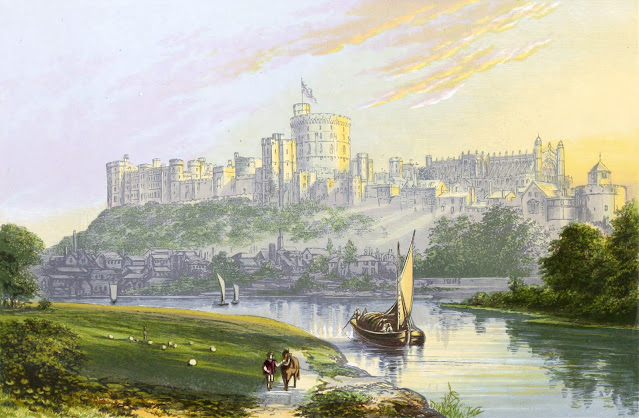


















.jpg)






























.jpg)


















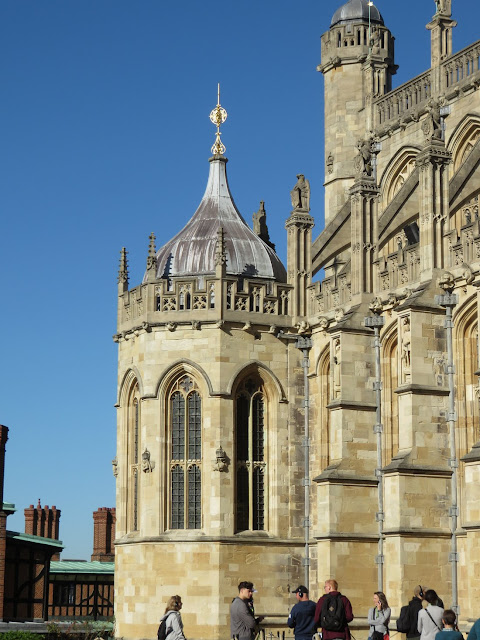





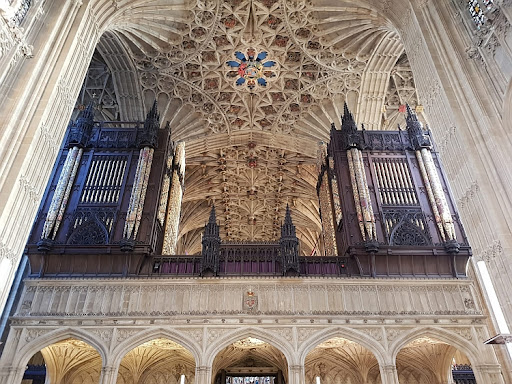







































.jpg)




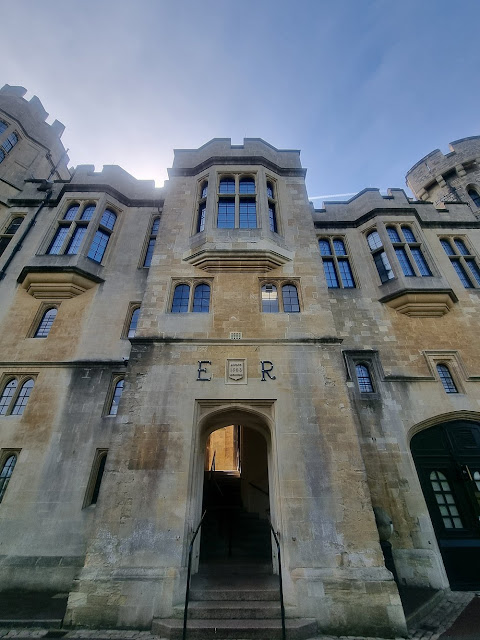









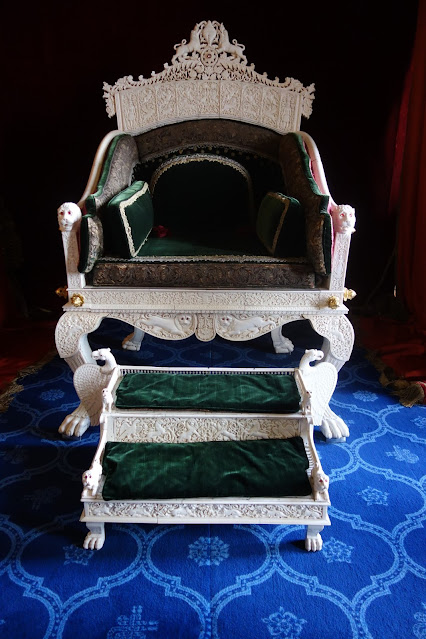





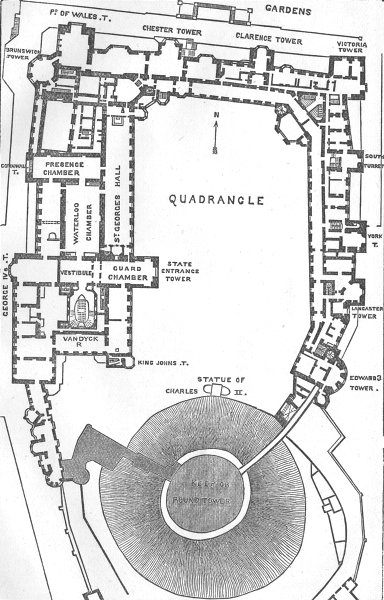








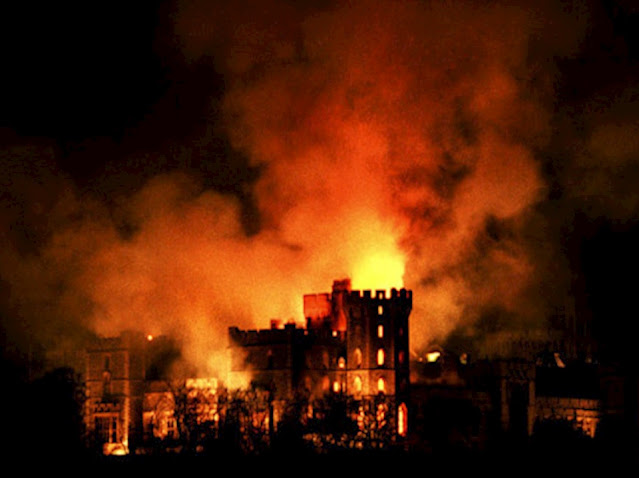


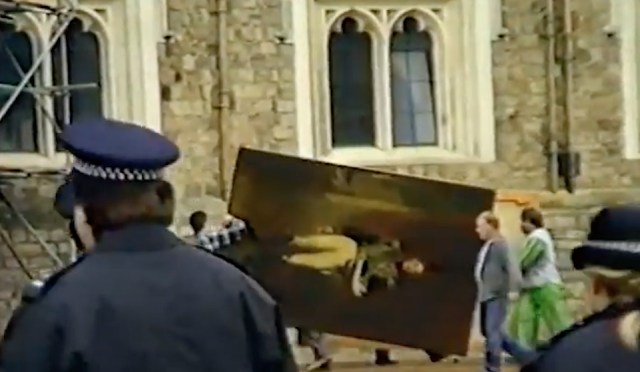



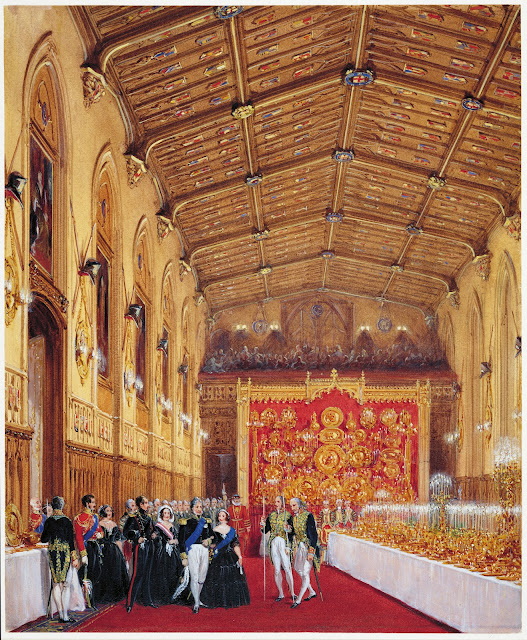














































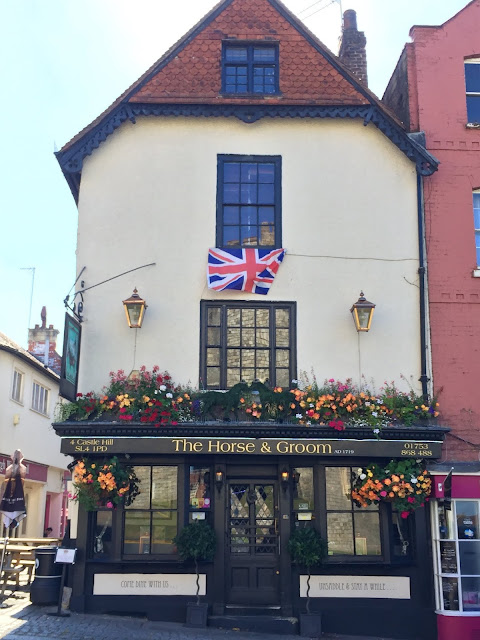




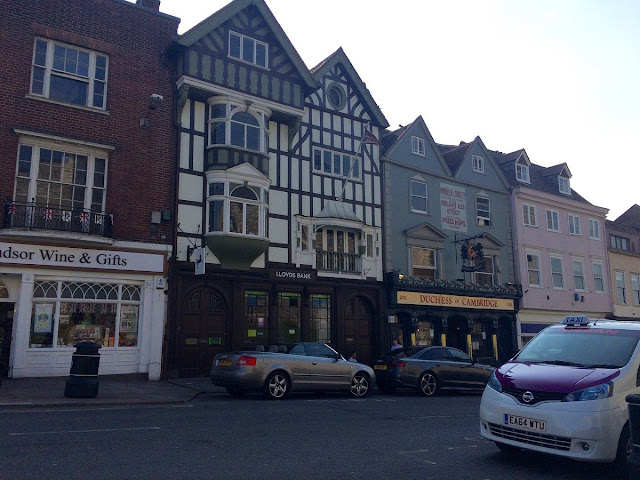










No comments:
Post a Comment
Don't be shy: leave your comments :)